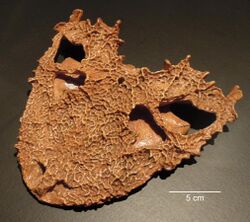Biology:Ankyramorpha
| Ankyramorphs | |
|---|---|

| |
| Skull of Lanthanosuchus watsoni, a lanthanosuchoid | |

| |
| Skeleton of Scutosaurus karpinskii, a procolophonian | |
| Scientific classification | |
| Domain: | Eukaryota |
| Kingdom: | Animalia |
| Phylum: | Chordata |
| Class: | Reptilia |
| Clade: | †Parareptilia |
| Order: | †Procolophonomorpha |
| Node: | †Ankyramorpha DeBraga & Rieppel, 1996 |
| Subgroups | |
| |
Ankyramorpha ("anchor forms") is an extinct clade of procolophonomorph parareptiles which lived between the early Cisuralian epoch (middle Sakmarian stage) and the latest Triassic period (latest Rhaetian stage) of Africa, Antarctica, Asia, Australia , Europe, North America and South America.[1][2]
This clade was named in a 1996 parareptile study by Michael deBraga and Robert R. Reisz. They provided the name Ankyramorpha for a newly recognized clade encompassing "the most recent common ancestor of Procolophonia and Lanthanosuchoidea and all its descendants", and this clade name sees continued use among modern parareptile studies.[3][4][5] A similar name, Hallucicrania, was provided in an earlier 1995 study by Michael S. Y. Lee, who defined it as the node-based taxon formed by the most recent common ancestor of lanthanosuchids and "pareiasauroids" (pareiasaurs + Sclerosaurus), and all its descendants. Unlike Ankyramorpha, which explicitly included procolophonoids, Hallucicrania was originally designed to exclude procolophonoids, which Lee's analysis argued to have split off prior to the divergence between lanthanosuchids and pareiasaurs.[6] Nevertheless, purely considering the taxa encompassed by their definitions, Hallucicrania and Ankyramorpha refer to an identical grouping.
The following cladogram is simplified after the phylogenetic analysis of MacDougall and Reisz (2014) and shows the placement of Ankyramorpha within Parareptilia. Relationships within emboldened terminal clades are not shown.[5]
| Parareptilia |
| ||||||||||||||||||||||||||||||||||||||||||||||||||||||||||||||||||||||||||||||||||||||||||||||||
References
- ↑ Marcello Ruta; Juan C. Cisneros; Torsten Liebrect; Linda A. Tsuji; Johannes Muller (2011). "Amniotes through major biological crises: faunal turnover among Parareptiles and the end-Permian mass extinction". Palaeontology 54 (5): 1117–1137. doi:10.1111/j.1475-4983.2011.01051.x.
- ↑ Jalil, N. E., & Janvier, P. (2005). Les pareiasaures (Amniota, Parareptilia) du Permien supérieur du Bassin d’Argana, Maroc. Geodiversitas, 27(1), 35-132.
- ↑ Michael deBraga; Robert R. Reisz (1996). "The Early Permian Reptile Acleistorhinus pteroticus and Its Phylogenetic Position". Journal of Vertebrate Paleontology 16 (3): 384–395. doi:10.1080/02724634.1996.10011328.
- ↑ Linda A. Tsuji; Johannes Müller; Robert R. Reisz (2012). "Anatomy of Emeroleter levis and the Phylogeny of the Nycteroleter Parareptiles". Journal of Vertebrate Paleontology 32 (1): 45–67. doi:10.1080/02724634.2012.626004.
- ↑ 5.0 5.1 Mark J. MacDougall; Robert R. Reisz (2014). "The first record of a nyctiphruretid parareptile from the Early Permian of North America, with a discussion of parareptilian temporal fenestration". Zoological Journal of the Linnean Society 172 (3): 616–630. doi:10.1111/zoj.12180.
- ↑ Michael S. Y. Lee (1995). "Historical Burden In Systematics And The Interrelationships Of 'Parareptiles'". Biological Reviews 70 (3): 459–547. doi:10.1111/j.1469-185X.1995.tb01197.x.
Wikidata ☰ Q4766123 entry
 |

